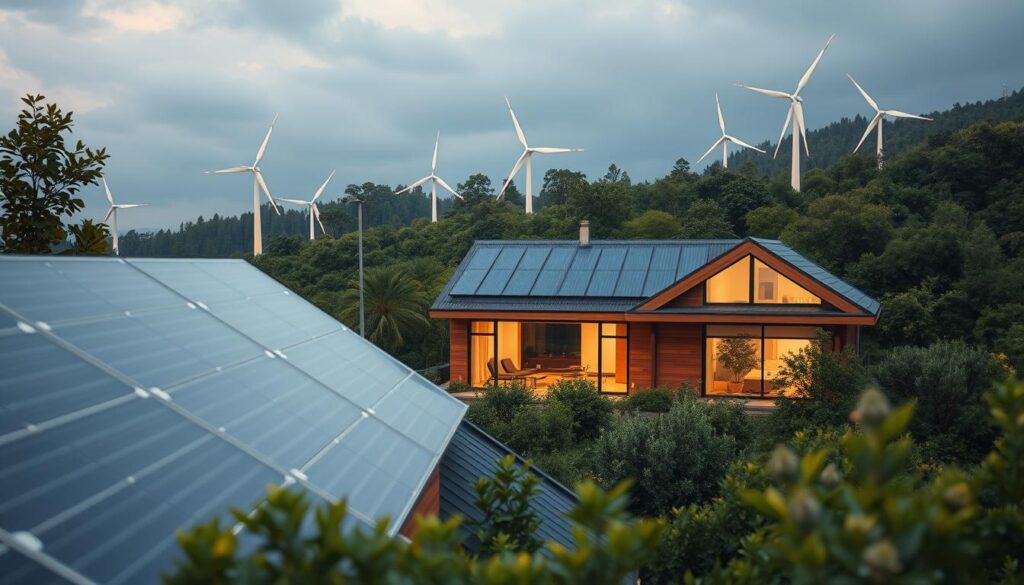Did you know that energy-efficient appliances can reduce energy consumption by 10-50% compared to standard models? This is just one of the many ways to transform your home into a more eco-friendly space. By making small changes, you can save on utility bills while helping the environment1.
Creating a sustainable home starts with choosing the right products. ENERGY STAR®-certified appliances, for example, are designed to use less energy without sacrificing performance. Pairing these with natural cleaning methods can further reduce your household’s environmental impact1.
From upgrading to LED bulbs to investing in proper insulation, there are countless ways to make your home more efficient. This guide will walk you through actionable steps, from sustainable design to community advocacy, so you can start making a difference today.
Key Takeaways
- Energy-efficient appliances can cut energy use by 10-50%.
- LED bulbs use 75% less energy and last 25 times longer.
- Proper insulation saves 20-30% on heating and cooling costs.
- ENERGY STAR® products are a smart choice for efficiency.
- Natural cleaning methods reduce harmful chemicals in your home.
Understanding the Fundamentals of a Sustainable Home
Building a sustainable home starts with understanding how to conserve resources and reduce waste effectively. A sustainable home is designed to minimize its environmental impact while maximizing efficiency and comfort for your family.

What Defines a Sustainable Home?
A sustainable home focuses on preserving natural resources and reducing waste. It incorporates energy-efficient systems, water-saving fixtures, and materials that are renewable or recycled. For example, LED bulbs use 75% less energy than traditional incandescent lighting2.
Proper insulation and programmable thermostats can reduce energy waste by 10-30%, making your home more efficient2. These things not only lower utility bills but also contribute to a healthier environment.
Core Principles of Sustainable Design
Sustainable design revolves around three key principles: efficiency, conservation, and innovation. Efficient use of resources like water and energy is crucial. For instance, water-efficient fixtures can reduce consumption by 20-30%2.
Conservation involves using natural resources wisely. Bamboo, for example, grows up to three feet per day, making it a highly renewable material3. Innovation includes integrating technologies like solar panels, which now convert up to 25% of sunlight into electricity2.
By adopting these principles, your family can enjoy long-term benefits while reducing environmental impact. It’s about making smart choices that balance comfort, cost, and sustainability.
Green Living: Transforming Your Daily Routine
Small changes in your daily routine can lead to a more sustainable lifestyle. By making thoughtful choices, you can reduce your environmental impact and contribute to a healthier planet. From the way you commute to the products you use, every decision matters.

Adopting Eco-Friendly Habits
Simple changes in your daily life can make a big difference. For example, carrying a reusable bag instead of relying on plastic ones can prevent hundreds of plastic bottles from polluting the environment each year4. Opting for secondhand items also reduces waste and supports a circular economy.
Reducing car usage is another effective way to lower your carbon footprint. Cycling 10 km each way to work instead of driving can save 1.3 tonnes of CO2 emissions annually4. If driving is a need, consider carpooling or using public transportation to minimize emissions.
Integrating Renewable Energy Solutions
Switching to renewable energy is a powerful choice for a sustainable future. Homes with solar panels can save one tonne of carbon per year5. Additionally, air source heat pumps can generate 4kW of thermal energy for every 1kW of electricity used, making them highly efficient5.
Choosing 100% renewable electricity can significantly reduce reliance on fossil fuels6. These solutions not only lower energy costs but also contribute to a cleaner environment. By integrating these practices into your daily life, you can make a lasting impact.
| Eco-Friendly Habit | Environmental Impact |
|---|---|
| Using Reusable Bags | Prevents 156 plastic bottles from polluting the environment annually4 |
| Cycling Instead of Driving | Saves 1.3 tonnes of CO2 emissions per year4 |
| Installing Solar Panels | Reduces carbon emissions by one tonne annually5 |
Eco-Friendly Kitchen and Household Practices
Transforming your kitchen into an eco-friendly space starts with smart choices. From energy-efficient appliances to natural cleaning methods, small changes can make a big difference. These practices not only save money but also protect the environment.

Energy-Efficient Appliances and Tools
Choosing the right appliances can significantly reduce energy usage. ENERGY STAR®-certified models, for example, use 10-50% less energy than standard ones7. Induction cooktops are another great option, using 25% less energy than traditional stoves7.
LED lighting is another simple upgrade. These bulbs use 75% less energy and last longer than incandescent ones7. By selecting the right tools, you can save energy in every room of your home.
Natural Cleaning and Maintenance Tips
Switching to natural cleaning solutions is both affordable and effective. Ingredients like vinegar and lemon can replace harsh chemicals, reducing chemical waste by 30%7. These options are safer for your family and the planet.
Proper maintenance also plays a key role. Fixing a leaking faucet, for instance, can save 3,000 gallons of water annually7. Timely repairs and mindful product choices ensure your home runs efficiently.
| Practice | Benefit |
|---|---|
| ENERGY STAR® Appliances | Save $300 annually on energy bills7 |
| Natural Cleaning Solutions | Reduce chemical waste by 30%7 |
| LED Lighting | Cut energy use by 75%7 |
The market for eco-friendly products is growing, making it easier to find sustainable options. By adopting these practices, you can create a healthier environment while saving time and money.
Optimizing Water Usage and Waste Reduction
Water is a precious resource, and optimizing its use is essential for a sustainable future. By adopting eco-friendly practices, you can reduce waste and protect the planet. From conserving water to managing household waste, small changes can lead to significant environmental benefits.

Water Conservation Techniques
Most residential water use occurs indoors, with 20% attributed to showering and 24% to flushing toilets8. Installing low-flow fixtures can reduce water consumption without sacrificing performance9. Smart irrigation systems also help by optimizing watering schedules based on weather conditions8.
Reusing water from cooking, such as boiling food, is another effective way to conserve resources10. Fixing leaks promptly can save thousands of gallons annually, making a big difference in your household’s water usage8.
Strategies to Minimize Household Waste
Reducing waste starts with mindful consumption. Composting organic materials like food scraps can significantly cut down on landfill waste10. Recycling and using reusable products also contribute to a cleaner environment.
Properly managing your dishwasher and washing machine settings can prevent water waste. Running full loads ensures efficient use of resources10. These eco-friendly habits not only save water but also reduce your utility bills.
- Install low-flow fixtures to reduce water usage9.
- Fix leaks promptly to save thousands of gallons annually8.
- Compost organic waste to minimize landfill contributions10.
- Run full loads in dishwashers and washing machines for efficiency10.
Sustainable Shopping and Reducing Plastic Consumption
Every purchase you make has an environmental impact, from the materials used to the waste generated. Millions of tons of plastic waste are produced globally each year, with a significant portion ending up in oceans11. By adopting sustainable shopping practices, you can reduce your consumption and contribute to a healthier planet.

Choosing Organic and Secondhand Products
Opting for organic and secondhand items can minimize your environmental footprint. Organic farming is more sustainable than traditional methods, reducing harmful chemicals in the soil and water12. Secondhand clothing extends the life of garments, reducing the demand for new production and cutting down on waste.
Fast fashion is a major contributor to plastic pollution, with synthetic fibers like polyester releasing microplastics into waterways11. By choosing ethical brands and secondhand options, you can help mitigate this issue. For example, companies like Patagonia invest in repair centers to extend the life of their products12.
Actionable Tips for Reducing Plastic Waste
Here are some practical steps to reduce plastic consumption while shopping:
- Use reusable bags, which can replace over 22,000 plastic bags in their lifetime12.
- Refuse single-use plastic items like straws and cutlery.
- Purchase in bulk to minimize packaging waste.
- Support brands that prioritize sustainability, such as those certified by Fair Trade USA or USDA Organic12.
| Practice | Impact |
|---|---|
| Using Reusable Bags | Reduces plastic waste by thousands of bags annually12 |
| Buying Secondhand Clothing | Cuts down on textile waste and microplastic pollution11 |
| Supporting Sustainable Brands | Encourages eco-friendly production practices12 |
By being mindful of each item you purchase, you can make a significant difference in reducing plastic waste and promoting sustainable fashion. Small changes in your shopping habits can lead to a cleaner, healthier planet for future generations.
Innovative Home Improvements for Energy Efficiency
Innovative home upgrades not only enhance comfort but also reduce environmental impact. By investing in modern solutions, you can create a more sustainable habitat while lowering your carbon footprint. These improvements are designed to save energy, reduce reliance on fuel, and contribute to a healthier planet.

Investing in Insulation and Energy-Saving Windows
Proper insulation is a game-changer for energy efficiency. Cavity wall insulation can reduce heat loss, cutting energy bills by up to 20%13. ENERGY STAR® certified windows also play a key role, lowering household energy costs by an average of 12%13.
These upgrades not only save money but also create a more comfortable indoor habitat. By minimizing the need for constant heating, you reduce wear and tear on appliances, extending their lifespan14.
Harnessing the Power of Solar Energy
Solar energy is a renewable solution that significantly reduces reliance on traditional fuel sources. Homeowners can benefit from a Federal Solar Investment Tax Credit, covering 26% of installation costs13. This investment pays off by lowering energy bills and reducing your carbon footprint.
Solar panels also increase property value, making your home more attractive to buyers15. By adopting this technology, you contribute to a cleaner habitat while enjoying long-term savings.
- Insulation upgrades can save up to 20% on heating and cooling costs13.
- Energy-saving windows reduce energy bills by an average of 12%13.
- Solar panels offer a 26% tax credit and lower energy expenses13.
These improvements are not just about saving money—they’re about creating a sustainable habitat for your plant and future generations. Whether it’s your home or office, these upgrades make a lasting impact.
Embracing Sustainable Fashion and Lifestyle Choices
The fashion industry’s rapid growth has led to significant environmental challenges. From excessive waste to high carbon emissions, the way we produce and consume clothing impacts the planet. In the United States, consumers are becoming more alert to these issues and seeking ways to reduce their footprint.

Fast fashion is a major contributor to global waste, with 85% of textiles ending up in landfills each year16. This overproduction not only depletes resources but also relies heavily on fossil fuels and harmful chemicals like pesticides. By choosing sustainable alternatives, we can mitigate these effects.
Reducing Fast Fashion and Supporting Ethical Brands
One of the most effective ways to reduce your footprint is by avoiding fast fashion. Instead, opt for ethical brands that prioritize sustainability. For example, organic cotton reduces pesticide use by 98% compared to conventional methods16. Supporting these brands also promotes fair labor practices, improving worker wages by up to 300%16.
Here are actionable steps to embrace sustainable fashion:
- Choose secondhand or upcycled clothing to extend garment lifespans16.
- Support brands certified by Fair Trade USA or USDA Organic17.
- Be alert to greenwashing and research brands’ sustainability claims.
Textile production in the United States and globally consumes vast amounts of water and energy. By shifting to eco-friendly fabrics, we can reduce energy consumption by up to 30%16. These choices not only benefit the environment but also encourage innovation in the fashion industry.
Consumers in the United States have the power to drive change. By making mindful purchases and supporting ethical brands, we can reduce our reliance on fossil fuels and harmful pesticides. Together, we can create a more sustainable future for fashion.
Community Engagement and Policy Advocacy for the Environment
Community-driven efforts are reshaping the way we address environmental challenges. From local initiatives to nationwide campaigns, collective action is essential for creating a sustainable world. By engaging with your community and advocating for policy changes, you can make a lasting impact.

Taking Action Through Local Initiatives
Local initiatives play a crucial role in driving environmental change. Studies show that projects involving communities have a 30% higher success rate in achieving sustainability goals18. For example, community-led reforestation projects result in a 70% survival rate of planted trees, compared to just 40% in non-community-led efforts18.
Participating in local service projects, such as tree planting or waste management, can significantly reduce environmental harm. In Pune, India, community-driven waste collection models recycle or compost 50% of the city’s waste, showcasing the power of collective action19.
Advocating for Renewable Energy Policies
Policy advocacy is another powerful tool for environmental change. Supporting renewable energy policies can reduce reliance on fossil fuels and promote cleaner alternatives. Climate assemblies, for instance, generate proposals that are more progressive than existing national policies20.
Engaging in civic initiatives, such as climate assemblies, fosters high-quality deliberation on environmental issues20. By advocating for renewable energy, you contribute to a healthier world and inspire others to take action.
“Collective action is the cornerstone of meaningful environmental change.”
Here are actionable steps to get involved:
- Join local service projects like tree planting or clean-up drives.
- Support renewable energy policies and advocate for their implementation.
- Make mindful shopping choices to reduce waste and support sustainable brands.
- Educate others about the importance of reducing fossil fuel dependency.
By taking these steps, you can turn your commitment into a gift for future generations. Together, we can build a sustainable world through community engagement and policy advocacy.
Conclusion
Adopting sustainable practices is not just a trend—it’s a necessity for a healthier planet. By integrating renewable energy solutions like solar panels, you can reduce your carbon footprint and save on energy costs21. Energy efficiency measures, such as insulation and LED lighting, further enhance these benefits, cutting utility bills by up to 20%22.
This guide serves as a valuable source for making informed, eco-friendly choices. From sustainable shopping to community engagement, every action counts. Ethical fashion and plant-based diets also play a crucial role in reducing environmental harm22.
Take the first step today. Implement these practices and explore additional resources to make a lasting impact. Together, we can create a cleaner, more sustainable future.
FAQ
What defines a green home?
How can I adopt eco-friendly habits in my daily routine?
What are the benefits of energy-efficient appliances?
How can I conserve water at home?
What are some strategies to minimize household waste?
Why is choosing secondhand products important?
How can solar energy benefit my home?
How can I reduce my reliance on fast fashion?
What role do local initiatives play in environmental sustainability?
How can I advocate for renewable energy policies?
Source Links
- Sustainable Living – https://ecolifematters.com/sustainable-living/
- The Complete Beginner’s Guide to Sustainable Living in 2025 – Earthava – https://www.earthava.com/guide-to-sustainable-living/
- Sustainable Interior Design Guide for 2025 | AND Academy – https://www.andacademy.com/resources/blog/interior-design/sustainable-interior-design-guide/
- Daily Habits: Sustainability Practices: Green Living: Adopting Sustainability Practices in Your Daily Routine – FasterCapital – https://fastercapital.com/content/Daily-Habits–Sustainability-Practices—Green-Living–Adopting-Sustainability-Practices-in-Your-Daily-Routine.html
- 40 Ways to Be More Eco Friendly in 2025 | GreenMatch – https://www.greenmatch.co.uk/blog/how-to-be-more-eco-friendly
- The Ultimate 20 step Guide to Eco-friendly Living | Good Energy – https://www.goodenergy.co.uk/blog/the-ultimate-20-step-guide-to-eco-friendly-living/
- How to Create a Sustainable Kitchen: 7 Eco-Friendly Practices for Every Home | Cosmo Appliances – https://cosmoappliances.com/how-to-create-a-sustainable-kitchen-7-eco-friendly-practices-for-every-home/
- Ways to Optimize Your Water Usage – The Benefit of Smart Irrigation Technology – https://nwi.life/article/ways-to-optimize-your-water-usage-the-benefit-of-smart-irrigation-technology/
- Water Management: Strategies for Sustainable Usage – Water & Wastewater – https://www.waterandwastewater.com/water-management-strategies-for-sustainable-usage/
- Three Ways to Reduce Water Consumption in Your Kitchen – My Green Montgomery – https://mygreenmontgomery.org/2024/three-ways-to-reduce-water-consumption-in-your-kitchen/
- Sustainable Living: Reducing Plastic Waste in Your Daily Routine – https://www.waterdrop.com/blogs/magazine/sustainable-living-reducing-plastic-waste-in-your-daily-routine
- 11 Sustainable, Eco-Friendly Shopping Tips to Help You Go Green – Kiwi Energy – https://kiwienergy.us/blog/11-sustainable-eco-friendly-shopping-tips-to-help-you-go-green/
- Affordable And Sustainable Ways for Energy Efficient Homes – https://energycentral.com/c/cp/affordable-and-sustainable-ways-energy-efficient-homes
- How to Boost Your Home’s Eco-Friendliness with Innovative Home Insulation Solutions – https://www.greenlivingblog.org.uk/how-to-boost-eco-friendliness-with-innovative-home-insulation/
- Smart Home Innovations for Energy Efficiency – One Hour Air Conditioning & Heating Fort Worth TX & North Dallas / Plano Area. Gladly servicing the Fort Worth and North Dallas Area. – https://www.onehourairftworth.com/smart-home-innovations-for-energy-efficiency/
- Embracing Sustainable Fashion: Empowering Young Women Through Conscious Style Choices — Top Buttons – https://www.topbuttons.org/fashion/embracing-sustainable-fashion-empowering-young-women-through-conscious-style-choices
- Environmental Sustainability in the Fashion Industry – https://www.genevaenvironmentnetwork.org/resources/updates/sustainable-fashion/
- Community Involvement in Environmental Protection as a Key to Successful Environmental Projects – One More Tree Foundation – https://one-more-tree.org/blog/2024/04/05/community-involvement-in-environmental-protection-as-a-key-to-successful-environmental-projects/
- Community Engagement for Sustainability: A Blueprint for Inclusive Development – https://thecsruniverse.com/articles/community-engagement-for-sustainability-a-blueprint-for-inclusive-development
- Environmental Education and Civic Engagement | eePRO – https://eepro.naaee.org/community/blog/environmental-education-and-civic-engagement
- Embracing Green Living: The Growing Movement Towards Sustainability – The Environmental Blog – https://www.theenvironmentalblog.org/2024/07/embracing-green-living-the-growing-movement-towards-sustainability/
- Why Is Green Living Important? Benefits Your Life and the Planet | What is Green Living? – https://whatisgreenliving.com/why-is-green-living-important/
